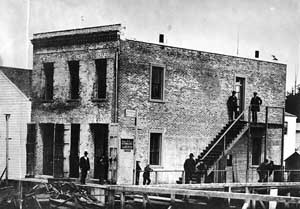On July 5, 1858, T. G. Richards & Co. purchases a lot “having a front on E and Centre Street” in the town of Whatcom on Bellingham Bay for $600. They start building a brick warehouse that will be the first brick building in Washington Territory. At the time some 10,000 miners are pouring into the town on their way to the Fraser gold fields in British Columbia. The company hopes to make a killing by selling goods to these miners. Joining the owners, Thomas G. and Charles Richards, is John G. Hyatt. All three men are from San Francisco.
In the summer of 1858, the community of Whatcom was booming. T. G. Richards & Co. saw a great opportunity to make money on the incoming surge of population eager to get to the Fraser gold fields. First they built a wood-framed store from which to sell their goods, and then turned their attention to the construction of their "fireproof" warehouse at E and Centre Street.
"They are clearing ground for the erection of a two story brick store and banking," the editor of The Northern Light announced in his July 24th edition. The "ground" was a tide flat and such a structure was unusual in a frontier settlement like Whatcom. The news item spoke of permanency.
The foundation and upper walls were made of brick hauled around Cape Horn all the way from Philadelphia as ballast in a ship. The builders laid it four rows thick and alternated the direction of bricks on each level. The foundation rested on the sand of the tidal flat. (Some drawings show a pad of stone underneath.)
By the end of the first week, the walls had gone up "six feet or eight feet" and the joice (joists) for the first floor was ready to be put in place. Center supports made of sixteen-inch cedar logs down the middle of the twenty-five-foot-wide building braced the floor. Iron shutters and doors were "on the ground, so that no delay will be occasioned in carrying the edifice forward to a speedy completion." Once the men started on the upper walls, which were three bricks thick, the work did go quickly. On August 28th, the paper ran an ad announcing that T. G. Richards & Co. was ready to carry a "storage and commission business." The post office moved in not long after.
A short time after the building was completed permits to mine on the Fraser River were mandated, and miners left Bellingham Bay in droves for Victoria on Vancouver Island. Tents and shacks disappeared almost overnight, causing many businesses to fail, but T. G. Richards & Co. continued their mercantile business for the next four years.
Then in 1863, they sold the brick building for $2,000 in county warrants to Whatcom County, and it took on new life as a territorial courthouse. A "jail room" and "treasurer room" were on the first floor.
In those early years the building was the center of the social and political life of the frontier region. It housed a safe with all the town’s money, hosted school board meetings, saw theater productions, and heard political speeches, and court cases in the upstairs territorial court chambers. In 1873 the Bellingham Bay Mail moved in. Four years later, a drugstore opened on the first floor.
The County eventually sold the territorial courthouse to private interests. By then, the mudflats had been filled around the building, turning the first floor into a basement when the sidewalk was raised. In the twentieth century it housed a church, taxidermy, and art studios. Today, the Territorial Courthouse, as it is now known, is seeing new life in the hands of the Whatcom Historical Society, which intends to preserve and restore it. It is the oldest brick building in Washington state.

